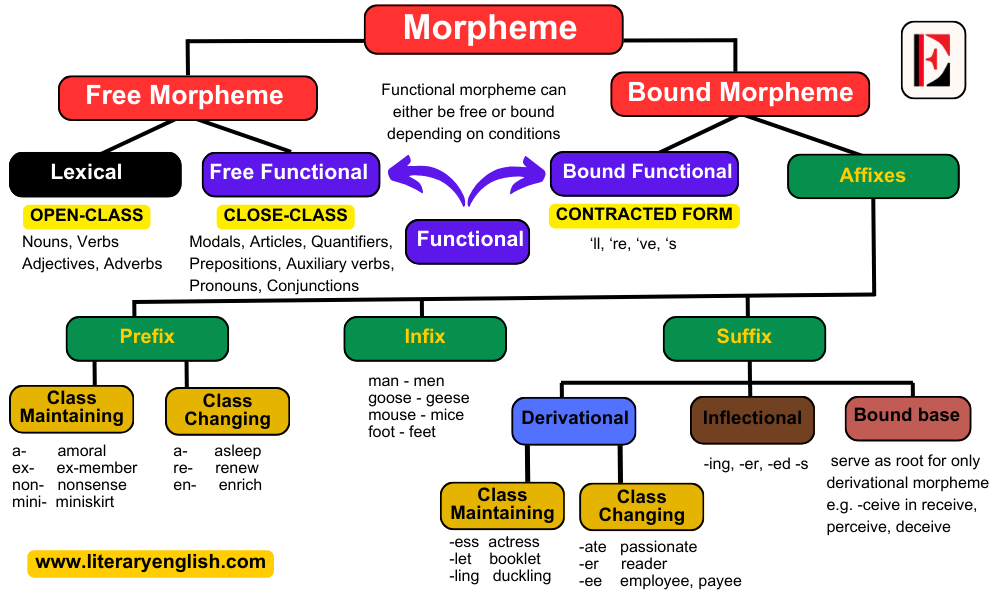What Is a Morpheme?
A morpheme is the minimal grammatical unit within a language. Every word comprises one or more morphemes. A standalone morpheme and a word are identical but when a root word becomes modify with addition of affixes, it becomes word only.
Look at the examples:
- Listen, listener, listened, listening
The root is listen is standalone morpheme and a word at a same time. When the root word was modifies with affixes like -s, -er, -ed and –ing it became a word consisting of a two morphemes in each word.
Types of Morpheme
There are two main types of morphemes
- Free morpheme
- Bound morpheme
Free Morphemes
The morpheme that can standalone as a single word (as a meaningful unit) is called free morpheme. The free morphemes are roots that are identical to words. Free morpheme are set of separate English word forms such as basic nouns, verbs, adjectives, etc. When a free morpheme is used with bound morphemes, the basic word forms are technically known as stems or roots.
Examples of free morphemes:
Sun (noun), dog (noun), walk (verb), and happy (adjective)
Free morpheme can standalone and cannot be subdivided further. ‘Sun’ or ‘dog’ are ‘free morphemes because they cannot be further split up, therefore the stems that cannot divide further are also called roots.
Free morphemes are divided into two categories: Lexical morphemes and functional morphemes.
-
Lexical morphemes (Open Class)
Lexical morphemes are a set of content words like nouns, verbs, adjectives, and adverbs. They can be understood fully e.g. run, blue, slow, paper, small, throw, and now. Lexical morphemes depict dictionary meaning of a word that is attributed to a specific referent.
- Functional Morphemes (Close Class)
Functional morphemes are set of functional words like conjunctions, prepositions, articles, pronouns, auxiliary verbs, modals and quantifiers. Some examples of functional morphemes are and, near, when, on, because, but, it, in, that, the, and above. Functional morphemes perform as a relationship between one lexical morpheme and another. A functional morpheme modifies the meaning, rather than supplying the root meaning of the word. It encodes grammatical meaning e.g.; the players entered the ground. In this sentence, ‘the’ is functional morpheme, which is specifying players and ground.
Bound Morphemes
Segments that cannot standalone and occur with another root/stem are called bound morphemes. Bound morphemes are also called affixes (prefixes, suffixes and infixes) in English. Two bound morpheme cannot occur together, but it is necessary for a bound morpheme to occur with a root/stem.
Examples of bound morphemes are :
- Opened: (Open + ed) = root + suffix
- Reopen: (Re + open) = Prefix + root
- Men: (Man + plural) = root + infix (infix makes a change inside a root word)
The set of affixes that make up the category of bound morphemes can also be divided into two types. Derivational morphemes and inflectional morphemes.
-
Derivational Morphemes
Derivational morphemes change the grammatical categories of words. For example, the word ‘bake’ (verb) is a root word (free morpheme) and when we add bound morpheme ‘er’(a suffix) with stem: it becomes baker (a noun), So the grammatical category was changed from verb to noun.
Derivational morphemes can either be class-changing or class-maintaining, depending on the change in the word. Class-maintaining maintain words’ original form and don’t change grammatical category of the word while class changing change the meaning of the root word to a new word.
Class Maintaining: These prefixes do not change the grammatical category of the base word.
Examples:
- a- (amoral)
- ex- (ex-member)
- non- (nonsense)
- mini- (miniskirt)
Class Changing: These prefixes can change the grammatical category of the base word.
Examples:
- a- (asleep)
- re- (renew)
- en- (enrich)
Class Maintaining: These suffixes do not change the grammatical category of the base word.
Examples:
- -ess (actress)
- -let (booklet)
- -ling (duckling)
Class Changing: These suffixes change the grammatical category of the base word.
Examples:
- -ate (passionate)
- -er (reader)
- -ee (employee)
-
Inflectional Morphemes
An inflectional morpheme is a suffix that is added to a word to assign a particular grammatical property to that word. For example, liste +ing = listening or boy+s = boys. They do not change the essential meaning or the grammatical category of a word. Inflectional morphemes serve as grammatical markers that indicate tense, number, possession, or comparison.
-
Bound Base
Bound bases serve as roots for only derivational morphemes and cannot stand alone. Example of the bound base morphemes is given below where –ceive is a bound base morpheme that cannot stand alone but it can form a word when used with prefixs:
-ceive (receive, perceive, deceive)
